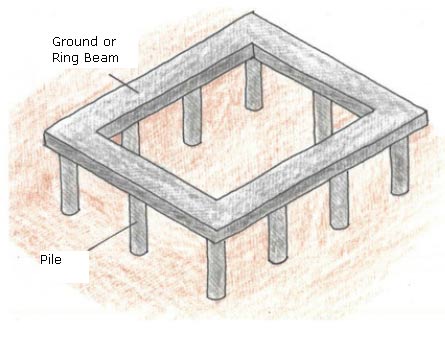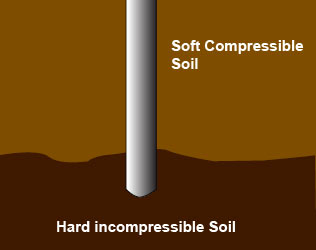There are numerous different types of foundations system that can be used during construction and each type generally has a specific use.
Where ground conditions are soft or otherwise unsuitable for traditional foundations, piling foundations are the ideal solution. Read on to find out all you need to know.
Understanding Pile Foundations: When and Why to Use Them
Pile foundations are a type of vertical foundation that extend deep into the ground to reach more stable soil. They’re necessary when the surface soil can’t support the weight of a structure effectively.
When a foundation needs to go beyond 3 meters below ground level, it’s considered deep. This differs from shallow foundations like strip foundations, pad foundations, and raft foundations.
Piles are used to distribute a building’s load from soft or unstable ground to firmer ground below. Typically made of concrete or steel, piles provide a stable base for construction.
In residential buildings, concrete or steel piles are connected at the top with a reinforced concrete beam known as a ring beam. This beam supports the superstructure, such as brickwork or block-work, above it.

Pile foundation with piles and reinforced ring beam
Pile foundations are used for economic or structural reasons, transferring the load to deeper, more stable ground. They’re essential when shallow foundations can’t support the load effectively.
They’re also employed to secure structures that may be prone to lifting or tipping, like chimneys. Piles anchor buildings against lateral forces to prevent tipping or falling over sideways.
Understanding Various Pile Construction Systems
In most cases, pile foundation construction involves driving a pile into the ground until it reaches a solid base.
There are several types of pile foundations, each falling into one of the following categories:
- Replacement or Bored Piles: These piles are placed into holes excavated from the ground, with concrete or steel filling the void. Commonly used in bridge construction.
- Displacement or Driven Piles: One of the most common forms of pile construction, these precast piles are hammered into the ground, displacing soil as they go. Typically made of steel or reinforced concrete, they’re not ideal for waterlogged or silty soil.
- Cast in-Situ: A temporary or permanent steel cage is driven into the earth, filled with concrete and the tube is either left for additional support or removed to create long lasting piles.
- Aggregate Piling: Similar to driven and cast in-situ, a temporary casing forms a hole that’s then backfilled with compacted aggregate as the cage is withdrawn.
- Screw Piling: This method involves screwing a steel tube with helical blades into the ground to create the pile, providing less disruption than other methods due to its slender profile.
Factors to Consider When Choosing a Piling System
When selecting a piling system for foundations, consider these four key factors:
- The load-bearing capacity required for the building or structure
- The cost compared to other foundation types
- The logistics of transporting heavy piling equipment to the site while minimising disruption
- The condition of the ground and surrounding soil layers
Piling is increasingly popular due to the rising costs of disposing of soil from traditional foundations.
Also generally, the closer together piles are placed, the less the diameter of each pile needs to be
In situations where a lot of subsidence has occurred, piles can be drilled through existing floor slabs to stop them sinking any further. This type of piling is called mini piling.
Micro piles, usually even smaller diameters, are used where access is very much restricted. Piles can also be used when underpinning a property that may be suffering from subsidence issues or other issues that have caused instability.
Exploring Different Types of Piles
Various types of piles are used in different situations, chosen based on ground conditions and the structure to be supported.
Here are explanations of some common pile types to help you understand their selection:
End Bearing Piles
End bearing piles support a building’s load by reaching down through soft soil to the harder bedrock below. These piles anchor into solid, unyielding strata, typically bedrock beneath loose soil.
These piles are widely used and easily understood.

End bearing pile going through soft soil and embedding in harder soil
Friction Piles
Friction piles are an alternative when end bearing piles are impractical, costly or need to run too deep. As they’re driven into deeper soil, they compact and strengthen it, providing some load-bearing capacity. Additionally, they gain extra support from the friction with surrounding soil, similar to a nail driven into wood.

Friction pile going through increasingly stiffening soil
Settlement Reducing Piles
These piles prevent settlement and subsidence by reinforcing the soil beneath foundations. They’re often used with other foundation types, like raft foundations, to reduce sagging in the centre of foundations by reinforcing the soil below.

Settlement reducing piles supporting sagging foundation
Tension Piles
Tension piles anchor tall structures into the ground, providing stability against lateral forces like wind. They counteract the building’s lateral movements in much the same way as the roots of a tree.
Factors Affecting the Type of Piles Used
The main factors that determine which type of pile will be used is as follows:
Location of the Pile and the Structure it will Support
When it comes to building structures over water like jetties, piers, or wharfs, driven displacement piles are often the ideal choice. However, on land, different factors come into play.
Displacement piles are usually cost-effective, but their use on land may cause vibrations affecting nearby buildings. In such cases, bored replacement piles become the preferred option.
For large structures requiring sizeable diameter piles, boring them into place often proves more economical.
When adding piles to existing structures, jack piles are commonly employed. These piles involve excavating the existing foundations and inserting sections of the pile beneath the building. Then, powerful jacks drive each section into the ground.

Inserting piles below a foundation using a powerful jack
Cost of Adding Piles
Cost is a crucial aspect of any construction project, especially when it involves piling. Various factors contribute to the overall cost, including:
- Material expenses for the piles
- Time required for pile construction
- Impact of chosen piles on the overall building expenses
- Cost of site excavation and preparation for pile installation
- Specialist contractor fees, including engineers for design and load testing, as well as skilled labour for construction
Designing Piles: Guidelines and Standards
Professional construction experts adhere to specific guidelines when designing pile foundations.
These foundations should comply with the Eurocodes, especially BS EN 1997-1, and for concrete structures, BS EN1992-1-1.
When constructing piles, the concrete must meet the standards outlined in BS 8500-1. Additional details can be found in the BRE Special Digest SD1, available for purchase from the Buildings Research Establishment: projects.bre.co.uk/sd1/wheretobuy.html.
Designing a piling system is a complex process, involving various unique factors for each situation. However, some common considerations include:
- Geological Survey: The choice of piling system depends largely on the type of ground, as each system is suited to different ground conditions.
- Structural Analysis: Computer modelling is used to analyse how the proposed structure reacts to forces like bending and shear. This data informs the final piling design.
- Structural Safety: Above all considerations, safety is paramount. The chosen piling system must be capable of supporting the structure under all possible circumstances.
Designing and constructing piles is a specialist task that involves a great deal of knowledge in ground types, material types, load calculations etc. so we would always recommend that you consult with a structural engineer or piling specialist.

